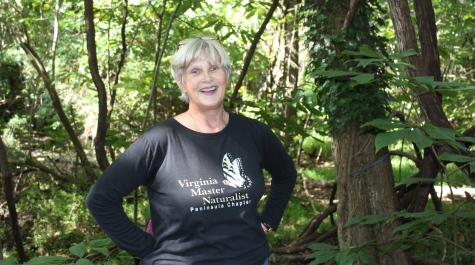Daina Henry '81, Ed.S. '94, Ed.D. '01
The following article is featured here with permission from The Daily Press about the work of alumnae and adjunct professor Daina Henry '81, Ed.S. '94, Ed.D. '01.
History has roots ... and soon a trail at Endview Plantation
Naturalists and organizations are working together to restore a trail at the Endview Plantation in Newport News.
By Adrienne Mayfield, amayfield@dailypress.com
4:32 p.m. EDT, August 28, 2014
NEWPORT NEWS – A Civil War trail is being restored at Endview Plantation this summer. Currently the trail is overgrown with invasive Japanese stiltgrass and pawpaws. But by next spring it will resemble the wildlife that Peninsula Campaign soldiers saw in the area 150 years ago, according to a naturalist who is leading the restoration effort.
Restoration began in June when Peninsula Master Naturalists identified 23 species of birds and 47 types of plants and trees on the quarter-of-a-mile long trail. The goal is to lay a defined trail, identify and tag plants and produce an educational brochure for visitors, said Daina Henry, a lead volunteer and master naturalist.
"It's just really cool to have something that you can take from wildness and bring it back to 'Oh, God, wouldn't this be a cool way to teach… about the history of the plantation and a little bit about what they used?" she said.
The trail is centered on a small natural spring that begins at Lebanon Run and feeds into the Newport News Reservoir, said Tim Greene, Endview's education specialist.
It's the same water source that drew people to the land and has diverse woody and marshy habitats in proximity, Henry said.
"There's a lot to see in a very short amount of time," she said. "The interesting thing about this trail versus a lot of other trails is its different habitats. You'll have totally different plants within a hundred yards of each other."
The trail is blooming with plant history. There are overgrown privets that may have once lined a driveway and a daffodil field where volunteers pulled 1,000 bulbs during the clean-up.
There is also a spicebush which Henry refers to as "poor man's potpourri" because it was historically used as fragrant wipes before indoor plumbing, she said.
"There's only one, so someone planted it," she said. "People plant things for a reason… It's just a matter of finding out why."
Naturalists have also found circumstantial evidence of a lost slave cemetery on the trail – traces of periwinkle, a tell-tale sign of old graves, Henry said.
"It would be nice if we could one day identify where the other cemetery is. Who knows, this just opens up another area of interpretation as far as the history of the site," said Laura Willoughby, Endview historic site coordinator.
This project has been made possible by volunteers from the Peninsula Master Naturalists, Boy Scout and Cub Scout troops and packs, the Navy and other community volunteers who have given physical labor, including clearing brush, pulling invasive plants and defining the trail.
"It's a great synergy of people who care… about nature. It [the trail] needs a lot of love, but it has so much potential," Henry said. "To me, it's an amazing place."
